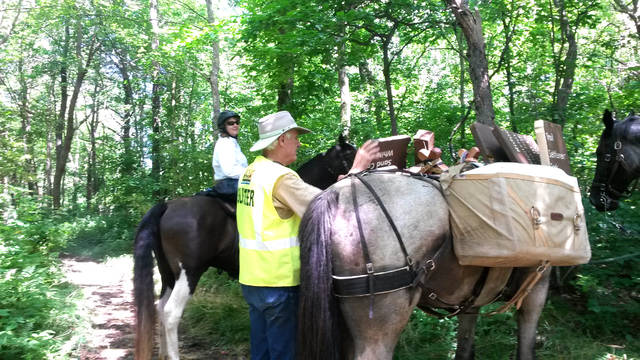Group mounts signs in national park
Published 5:41 pm Monday, July 30, 2018

Photo submitted
Horseman Susan Kiley and Rocky are ready to hit the trails with horseman Roy Cornett.
|
Getting your Trinity Audio player ready...
|
On the morning of July 18, a string of six horses and their riders, accompanied by two mules, embarked on the Ridge Trail in Cumberland Gap National Historical Park. Riders knew there was work to be done in the spectacular scenery in which they would be immersed, and they were prepared.
Eight trail signs needed to be mounted upon eight-foot posts, which first needed to be installed in holes that yet had to be dug. Twenty well-worn and faded signs and posts also had to be removed and transported back to staging areas. For the Back Country Horsemen (BCH) of Tennessee and Kentucky and staff at Cumberland Gap National Historical Park (NHP), the day would be one of pride, accomplishment, camaraderie, visitor enhancement and the beginning of a volunteer partnership that would not fade with the sunset.
Bobby Mitchell, President of the BCH of Tennessee, is ecstatic about the volunteer day.
“Our members, our horses and mules, park staff, and even the weather all worked beautifully together to make this day a success,” he said.
In addition to Mitchell, other BCH volunteers included Joanne Mitchell, Project Lead, BCH of Tennessee and Roy Cornett, Susan Kiley, Edith Conyers, and Anne Husted, all from the BCH of Kentucky.
Cumberland Gap NHP trail maintenance worker and accomplished horseman Darryl Day, who was the park lead in this joint project with the BCH, shares “the group travelled over 20 miles of trail and accomplished much more than park staff could on foot.”
The use of horses and mules is widespread in areas having wilderness or recommended wilderness, as such designations mandate minimal use of motorized vehicles and mechanized equipment. In 1978, more than 14,000 acres at Cumberland Gap NHP were recommended as wilderness under the Wilderness Act of 1964.
Almost 30 of the park’s 85 miles of trail are within this recommended wilderness. The park’s recommended wilderness – the largest protected wildlands in the Cumberland Mountains – offers extensive opportunities for solitude and primitive recreation in one of the most biologically rich and diverse forest ecosystems in the eastern United States.


